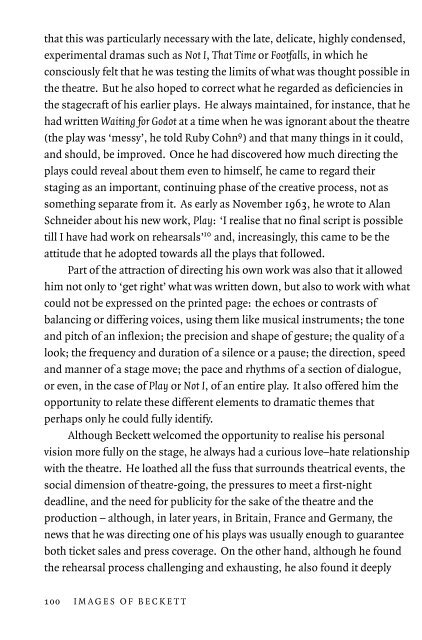You also want an ePaper? Increase the reach of your titles
YUMPU automatically turns print PDFs into web optimized ePapers that Google loves.
that this was particularly necessary with the late, delicate, highly condensed,<br />
experimental dramas such as Not I, That Time or Footfalls, in which he<br />
consciously felt that he was testing the limits <strong>of</strong> what was thought possible in<br />
the theatre. But he also hoped to correct what he regarded as deficiencies in<br />
the stagecraft <strong>of</strong> his earlier plays. He always maintained, for instance, that he<br />
had written Waiting for Godot at a time when he was ignorant about the theatre<br />
(the play was ‘messy’, he told Ruby Cohn 9 ) and that many things in it could,<br />
and should, be improved. Once he had discovered how much directing the<br />
plays could reveal about them even to himself, he came to regard their<br />
staging as an important, continuing phase <strong>of</strong> the creative process, not as<br />
something separate from it. As early as November 1963, he wrote to Alan<br />
Schneider about his new work, Play: ‘I realise that no final script is possible<br />
till I have had work on rehearsals’ 10 and, increasingly, this came to be the<br />
attitude that he adopted towards all the plays that followed.<br />
Part <strong>of</strong> the attraction <strong>of</strong> directing his own work was also that it allowed<br />
him not only to ‘get right’ what was written down, but also to work with what<br />
could not be expressed on the printed page: the echoes or contrasts <strong>of</strong><br />
balancing or differing voices, using them like musical instruments; the tone<br />
and pitch <strong>of</strong> an inflexion; the precision and shape <strong>of</strong> gesture; the quality <strong>of</strong> a<br />
look; the frequency and duration <strong>of</strong> a silence or a pause; the direction, speed<br />
and manner <strong>of</strong> a stage move; the pace and rhythms <strong>of</strong> a section <strong>of</strong> dialogue,<br />
or even, in the case <strong>of</strong> Play or Not I, <strong>of</strong> an entire play. It also <strong>of</strong>fered him the<br />
opportunity to relate these different elements to dramatic themes that<br />
perhaps only he could fully identify.<br />
Although <strong>Beckett</strong> welcomed the opportunity to realise his personal<br />
vision more fully on the stage, he always had a curious love–hate relationship<br />
with the theatre. He loathed all the fuss that surrounds theatrical events, the<br />
social dimension <strong>of</strong> theatre-going, the pressures to meet a first-night<br />
deadline, and the need for publicity for the sake <strong>of</strong> the theatre and the<br />
production – although, in later years, in Britain, France and Germany, the<br />
news that he was directing one <strong>of</strong> his plays was usually enough to guarantee<br />
both ticket sales and press coverage. On the other hand, although he found<br />
the rehearsal process challenging and exhausting, he also found it deeply<br />
100 IMAGES OF BECKETT


